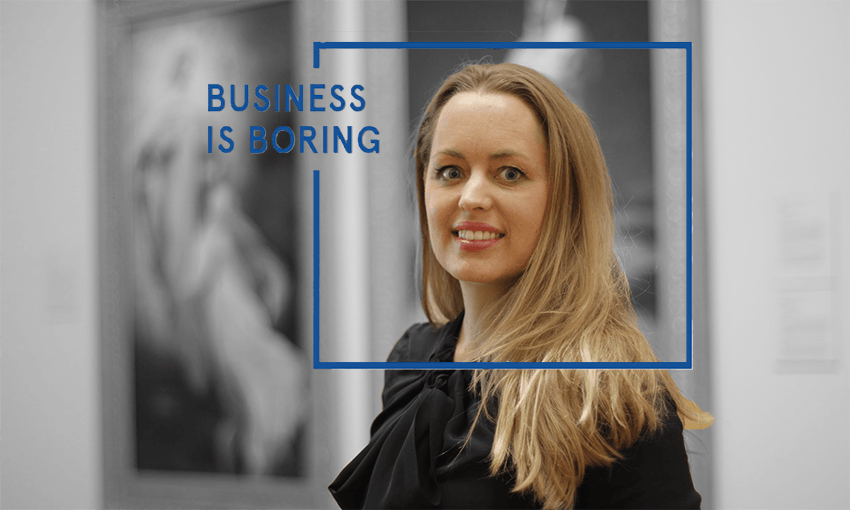Business is Boring is a weekly podcast series presented by The Spinoff in association with Callaghan Innovation. Host Simon Pound speaks with innovators and commentators focused on the future of New Zealand, with the interview available as both audio and a transcribed excerpt. This week Simon talks to Angie Judge about how she’s changing a thousands of years-old industry.
Museums and cultural attractions like zoos and art galleries might seem like traditional institutions, but actually, the best are at the forefront of using data to attract more visitors, and look after the ones they already have better thanks to Kiwi start-up Dexibit.
Started in only 2015, the other week they picked up Most Innovative Hi-Tech Solution and Most Innovative Hi-Tech Software Solution for the Creative Sector at the Hi-Tech Awards. They count some of the world’s great institutions as their clients, like the National Gallery in the UK and the Smithsonian, and locally, the Auckland Art Gallery and Te Papa have been right at the front of building out the tech.
Dexibit uses visitor data, machine learning and forecasting to allow institutions to know more about their visitors and to plan for and serve them better.
The founder and CEO of Dexibit, Angie Judge, joins us now to talk the entrepreneurs journey from idea through to being an integral part of the future of some of the world’s great attractions.
Either download this episode (right click and save), have a listen below or via Spotify, subscribe through iTunes (RSS feed) or read on for a transcribed excerpt.
Tell me how your idea came to be?
I was standing in the Smithsonian, which these days isn’t an unusual thing for me do but back then it was the first time I had. About 5 million people were going through that museum per year and I saw the security guard literally clicker-counting people through the door with one of those old fashioned clicker-counters.
It was 2015 and I just thought surely technology had moved on but it hadn’t. Sure enough, to this day many great museums around the world still clicker-count people through the door. Aside from being painful on the thumb, it doesn’t tell you about the visitors and what they do.
That really provided the inspiration for the company and the technology and the disruption that we wanted to bring to a sector that was quite under serviced in that space.
What was the journey in doing that, from having the realisation that tech could be used in that sector to where you are now, being in some of the world’s greatest museums?
We certainly went a fairly typical route of doing what they call a minimum viable product, of putting together the bases of our solution and understanding what the problem was. We focused really fast and really hard on going international. That’s been a huge advantage.
There’s only so many museums in New Zealand and they’ve been incredibly supportive innovators in their own right helping us put the idea together, but the real market was always in the US and UK and Europe. We headed out really quick and I think that was really crucial for us in being successful on that journey.
To be honest the company and the product looks really different than what I’d imagined. Giving yourself the freedom to start with an idea but not be too attached to it is a good thing. I initially thought that all of the special magic sauce would be about dashboarding and establishing a live view of what’s happening right now, but it turns out it’s more about what’s happening next. What the predictive analytics are saying is what’s most important to our customers.
Really listening to what people had to say and letting the idea take you where it will really helped us get to where we are today.
How would you describe the idea to a friend at a barbecue today?
Dexibit predicts, analyses and reports for visitor experience and exhibit performance in cultural and visitor attractions. In layman’s terms, if I was explaining that to my nana, that’s museums and galleries and zoos and parks and all of those places we enjoy going in our spare time. People who run those places like to understand what draws us there, what we’re doing once we get there, and what will help to bring us back in the future. It’s a typical marketing funnel, like any business – how do we attract more visitors, how do we get them to enjoy their time on site, to spend their money in the cafe or the shop and get them coming back as members or repeat visitors.
For this industry that’s incredibly important. You think about government grants which have traditionally sustained our cultural sector, and in many parts of the world they’re under enormous pressure right now. There are many changes happening in the tax world that are affecting donations and endowments and things like that. Like any business, these attractions are facing competition from random things like Netflix.
The ability to be commercially sustainable and to grow on their own right is incredibly important and the timeliness of that is so important right now. Analytics and particularly AI informed analytics becomes a really powerful tool in helping people achieve that.

